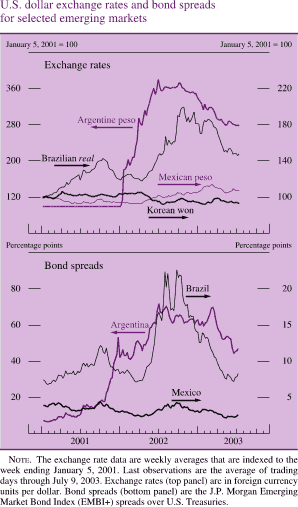Emergingmarket bond default rates may be set to lift off
Post on: 27 Июль, 2015 No Comment

LONDON, March 3 (Reuters) — A decade-long period of rock-bottom default rates on emerging- market debt looks to be coming to an end.
All the factors that fed a boom in overseas borrowing — fast economic growth, a weak dollar, booming commodity prices, and low U.S. interest rates — appear to be changing. And if the past is any indication, the $3 trillion emerging-market debt sector could be headed for trouble.
Historically, debt default in emerging markets has gone lock-step with episodes of dollar strength: the late 1990s, the Argentine, Turkish and Brazilian crises of 2001-2002 and the 2008 credit crunch are examples, shown in this graphic:
Emerging-market default rates stood at 0.76 percent at the end of 2014, a seven-year low and the fifth-lowest rate since 1981, according to calculations by Standard & Poor’s that were cited by Standard Chartered in a recent note.
But with the dollar up 20 percent in the past year against a basket of currencies, the sector may be edging toward another era of troubles.
You have cycles when emerging markets move in bunches, such as in the 1990s when defaults happened in a group, then things improved, and now again we are in a phase when the trend is weakening and there is more focus on defaults, said Costa Vayenas, the head of EM investment at UBS Wealth Management.
Any upcoming debt crisis will differ from previous cycles. With possible exceptions such as Ukraine and Venezuela, it is likely that defaults will centre on companies rather than governments.
Non-bank companies issued $554 billion in overseas debt during the 2009-2013 easy-money years, the Bank for International Settlements says. Many of them may have trouble repaying debt denominated in a rapidly strengthening dollar.
The emerging-market corporate bond sector is estimated to be worth around $2 trillion, or double 2010 levels.
DEFAULT RATES
Already this year, companies have chalked up defaults of over $3 billion. The delinquents range from Brazilian engineering firm OAS to miner Gran Colombia and Nigerian oil producer Afren. A debt restructuring by Chinese developer Kaisa may be followed by many others as a real estate slowdown bites, S&P says.
More tellingly, less than a tenth of the world’s companies are in emerging markets, but they accounted for a quarter of all defaults in 2014, Standard Chartered said. That was up from 5 percent in 2007 and reflected the relative deterioration in emerging-market corporate credit profiles.
This deterioration has only just begun to be translated into actual defaults, but the trend seems to have turned with respect to EM corporates, analysts at the bank wrote.
That is reflected in the sheer numbers of bonds that are trading at elevated yields. Corporate debt worth $132 billion was trading at distressed levels, or at yields over 1,000 basis points at the end of January, according to BNP Paribas. It says such steep yield rises often precede defaults.
BNP predicts $18.8 billion in corporate defaults in 2015, up a third from 2014 and possibly rising to $86 billion next year if Venezuelan state oil firm PDVSA falls.
One reason for the stress is the commodity cycle, which has seen oil and copper prices almost halve over the past year. A third of all emerging-market bonds are linked to commodities.
That is translating into ratings downgrades. A third of emerging-market companies carry negative credit outlooks, Standard Chartered says. In eastern Europe and the ex-Soviet Union it is as high as 65 percent
SLOW BURN
So far, investors don’t seem too worried. A recent $1 billion bond issue by low-rated Ivory Coast drew bids for four times that amount — perhaps unsurprising given the low or even negative yields on safe Western bonds.
We are not in the camp of being overly concerned at this stage. I would say there are pockets of situations rather than a general trend, said Nish Popat, a portfolio manager at Neuberger Berman.
Moreover, corporate default rates remain well below 2009 levels of 15 percent and a fraction of the 34 percent peak hit in 2002, says David Spegel, head of emerging debt at BNP Paribas.
The default probability priced by corporate bond markets is running at more than 4 percent for this year, but Spegel reckons a realistic end-year default rate is 3 percent, falling to 1 percent if governments are included. That may rise to 5.2 percent and 1.6 percent respectively by end-2016, he says.
That still doesn’t sound like much, and investors say that while the problem merits vigilance, it is not yet time to flee. Many also see fears for commodity exporters as overdone, since their revenue is in dollars.
If you look on a long-term basis, default rates among emerging market corporates are lower than on U.S. corporate high-yield. but there is an increase. Nonetheless, we still think it is very acceptable, Roy Scheepe, senior client portfolio manager at ING Investment Management, said. (Additional reporting by Karin Strohecker ; graphic by Vincent Flasseur)














